Help needed I have just set up my new subs, each one is housed in a custom 700mm wide, 600mm high, 700mm deep box, originally it sounded great then once I applied some filters from REW it messed up it is no longer acting like a sub but a speaker. I have since removed the filters hoping it would bring back the sound of the sub but it has stayed the same like no filters where applied. I have attached pictures and mdat files of the current REW results, and setup. The Dayton Audio are not sounding any different than my previous monolith plus subs. It seems like the speakers are acting as high pass all of a sudden. I have tried changing every part of the setup including using the amp from one of the monolith plus subs to power one of them. I have also tried it without the miniDSP connected to see if that would make a difference, however this did not change anything either. Please help this is driving me crazy all I want to hear is the deep bass shaking down my house 😂
Setup is as follows
Setup is as follows
- Yamaha RX-V585 AVR also tried Denon X3400H
- to MiniDSP 2x4 HD
- to Cleanbox Pro
- to Behringer NX4-6000
- to Dayton UM18-22
Attachments
-
Jul 17 org.mdat86.8 KB · Views: 101
-
Jul 17.mdat96.6 KB · Views: 93
-
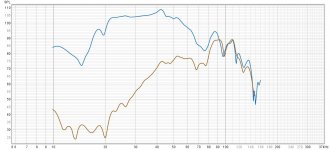 Sub readings REW.jpg156.2 KB · Views: 178
Sub readings REW.jpg156.2 KB · Views: 178 -
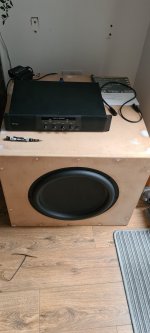 20220719_195227.jpg300.4 KB · Views: 225
20220719_195227.jpg300.4 KB · Views: 225 -
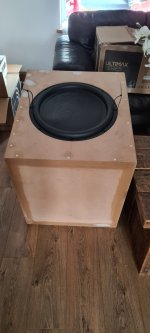 20220719_195235.jpg249.6 KB · Views: 227
20220719_195235.jpg249.6 KB · Views: 227 -
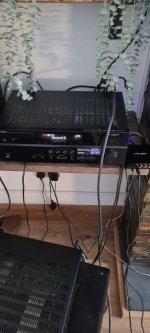 20220719_195201.jpg244.7 KB · Views: 160
20220719_195201.jpg244.7 KB · Views: 160 -
 20220719_195212.jpg200.4 KB · Views: 179
20220719_195212.jpg200.4 KB · Views: 179 -
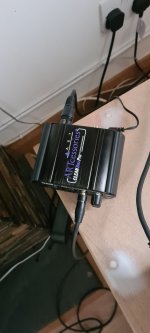 20220719_195219.jpg172.2 KB · Views: 183
20220719_195219.jpg172.2 KB · Views: 183 -
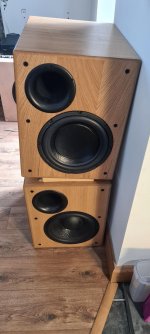 20220719_195413.jpg241 KB · Views: 168
20220719_195413.jpg241 KB · Views: 168
Have you checked to see if the driver is damaged? It might be hurt and the voice coil is burnt a little letting it still make sound just not the right sound. Make sure it can still move all the way smoothly.
I suppose my question is why do you expect it to sound much different to your monolith subs to start with?
The monoliths use high quality, low distortion, drivers suited to sub bass duties. They have plenty of power and are well built.
Low bass is subtle and tends not to smack you in the face anyway. You've shown a measurement that indicates 20Hz extension with a roll off at about 50Hz. What's wrong with this?
Two monoliths vs two UM18 boxes. What would I expect? The monoliths already have a design that will go down to 20Hz. We don't hear 20Hz so much as feel it. You will feel this more as a pressure change in the room with certain home theatre content or the odd sound effect in music. Most of the time this kind of extension isn't required. So the monoliths already have 20Hz extension and high excursion sub drivers with plenty of power. The UM18 have the potential to go louder and deeper but you're only going to notice this if you need the extra SPL and have EQd them a little to get the extension down below 20Hz.
Most of the time you won't need the extra SPL, or extension, and as the monoliths were highly capable, to begin with, they probably sounded great. Did you swap over to the UM18s because you exceeded the capabilities of the monoliths and made them bottom out etc?
The UM18s in boxes the size you've got don't need EQ to hit 20Hz as in room they should be fairly flat all the way to 20Hz. If you desire more then apply a shelving filter to tilt the bass up a little until you have a balance you like. Most people prefer a tilted up bass and this is especially so for HT.
For the best results use all four subwoofers in a multiple sub configuration which you can research on this forum.
The monoliths use high quality, low distortion, drivers suited to sub bass duties. They have plenty of power and are well built.
Low bass is subtle and tends not to smack you in the face anyway. You've shown a measurement that indicates 20Hz extension with a roll off at about 50Hz. What's wrong with this?
Two monoliths vs two UM18 boxes. What would I expect? The monoliths already have a design that will go down to 20Hz. We don't hear 20Hz so much as feel it. You will feel this more as a pressure change in the room with certain home theatre content or the odd sound effect in music. Most of the time this kind of extension isn't required. So the monoliths already have 20Hz extension and high excursion sub drivers with plenty of power. The UM18 have the potential to go louder and deeper but you're only going to notice this if you need the extra SPL and have EQd them a little to get the extension down below 20Hz.
Most of the time you won't need the extra SPL, or extension, and as the monoliths were highly capable, to begin with, they probably sounded great. Did you swap over to the UM18s because you exceeded the capabilities of the monoliths and made them bottom out etc?
The UM18s in boxes the size you've got don't need EQ to hit 20Hz as in room they should be fairly flat all the way to 20Hz. If you desire more then apply a shelving filter to tilt the bass up a little until you have a balance you like. Most people prefer a tilted up bass and this is especially so for HT.
For the best results use all four subwoofers in a multiple sub configuration which you can research on this forum.
It isn't that I'm expecting them to sound different the blue is when the UM18-22 was first plugged with no filters on and the orange is after an hour of use I suddenly noticed all the low end had died out so I tuck off all the filterds and reran a sweep the orange is what I got back, it like the power has gone completely on both the monoliths and the daytons. I had this problem with just the monoliths which is why I built the daytons thinking the monoliths where not so good but every so often a sweep the monoliths would shake the house down but would never repeat it.I suppose my question is why do you expect it to sound much different to your monolith subs to start with?
The monoliths use high quality, low distortion, drivers suited to sub bass duties. They have plenty of power and are well built.
Low bass is subtle and tends not to smack you in the face anyway. You've shown a measurement that indicates 20Hz extension with a roll off at about 50Hz. What's wrong with this?
Two monoliths vs two UM18 boxes. What would I expect? The monoliths already have a design that will go down to 20Hz. We don't hear 20Hz so much as feel it. You will feel this more as a pressure change in the room with certain home theatre content or the odd sound effect in music. Most of the time this kind of extension isn't required. So the monoliths already have 20Hz extension and high excursion sub drivers with plenty of power. The UM18 have the potential to go louder and deeper but you're only going to notice this if you need the extra SPL and have EQd them a little to get the extension down below 20Hz.
Most of the time you won't need the extra SPL, or extension, and as the monoliths were highly capable, to begin with, they probably sounded great. Did you swap over to the UM18s because you exceeded the capabilities of the monoliths and made them bottom out etc?
The UM18s in boxes the size you've got don't need EQ to hit 20Hz as in room they should be fairly flat all the way to 20Hz. If you desire more then apply a shelving filter to tilt the bass up a little until you have a balance you like. Most people prefer a tilted up bass and this is especially so for HT.
For the best results use all four subwoofers in a multiple sub configuration which you can research on this forum.
Yes I have checked that and they are smooth all the way down and still very stiff. There is no scratching either.Have you checked to see if the driver is damaged? It might be hurt and the voice coil is burnt a little letting it still make sound just not the right sound. Make sure it can still move all the way smoothly.
Okay so something in your system is applying a high-pass filter. You need to hunt down what it is that's doing it. My advice would be to use your computer sound card as a starting point and output that directly into a subwoofer amplifier. By the looks of things the highpass is attenuating 20Hz by about 60dB. This is a LOT. If you use a signal generator program to send 20Hz to the subwoofers and the cones flap around then I think you can assume there's no high-pass being applied in the plate amplifiers or the Behringers. Then send the output of the computer into the miniDSP without any EQ applied and see if the same thing happens. If the cones flat about then it's not the amplifiers or the miniDSP.
A 24dB octave high pass at 100Hz is roughly 60dB down by 20Hz. Or something within the ballpark anyway. Are you sure the HT receiver isn't applying a highpass to the system?
A 24dB octave high pass at 100Hz is roughly 60dB down by 20Hz. Or something within the ballpark anyway. Are you sure the HT receiver isn't applying a highpass to the system?